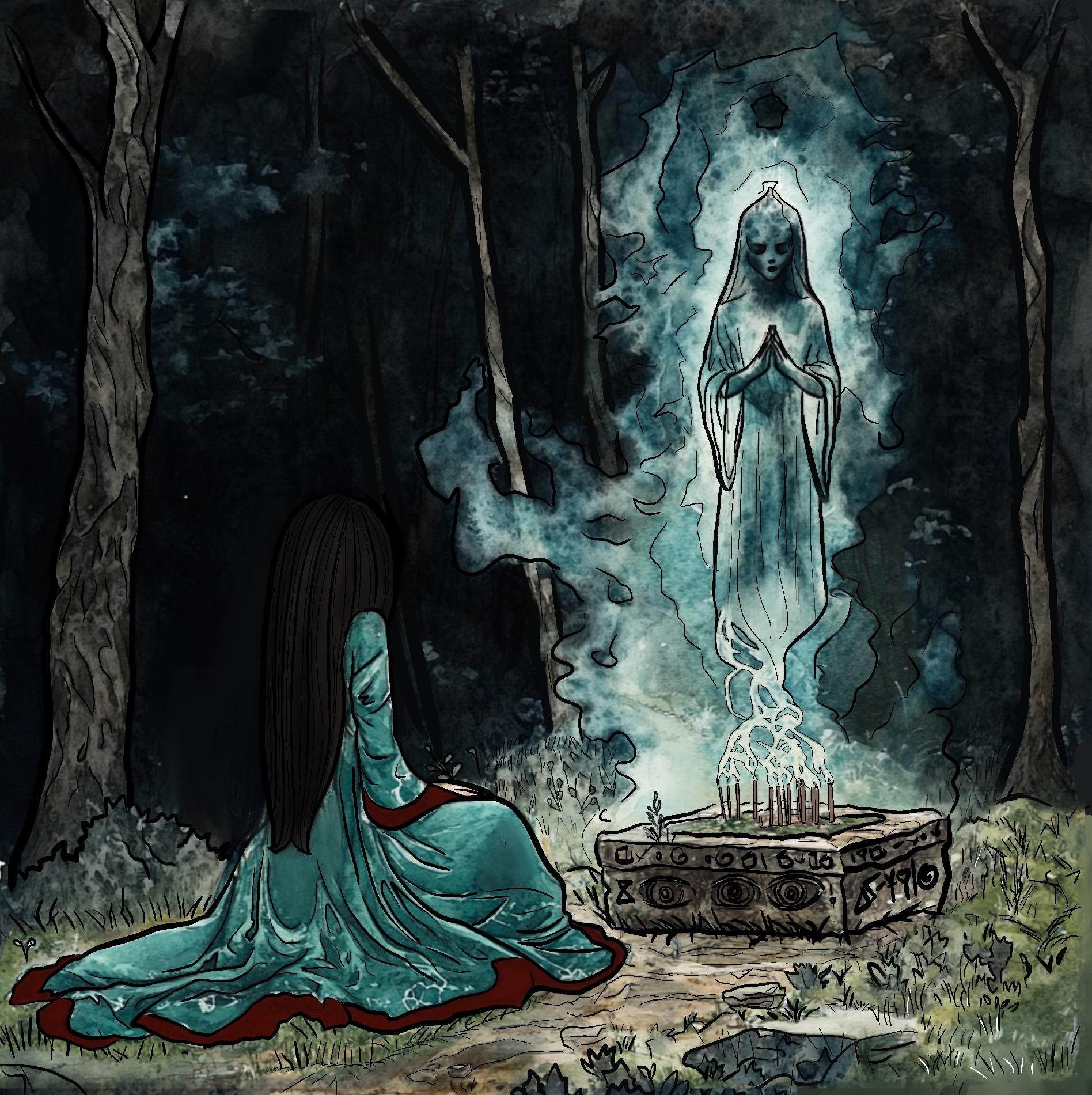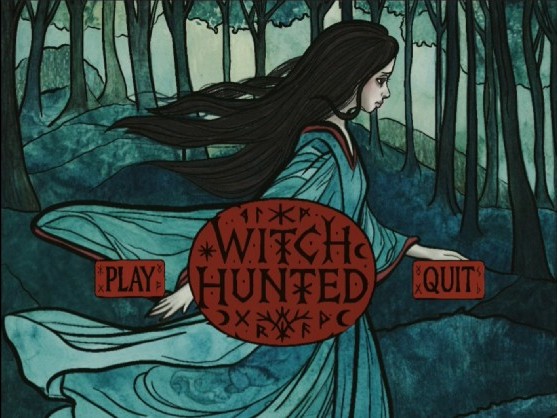Devlog #9 – Visual Tile Logic, Book Interface, Transition Effects and Patrol AI
Hey, thanks for reading. This week, I focused on improving my procedural forest by introducing a wall auto-tiling system. I also worked on setting up animated transitions for scene changes and combat, as well as creating a fully animated book interface to hold my game’s UI, and developing enemy patrol logic to bring the overworld to life. These systems are all foundational to the moment-to-moment experience of Witch Hunted, so I spent time getting them set up in a way that is clean, modular, and ready to expand later.
1. Wall Auto-Tiling System with Bitmasking
I implemented a system that automatically assigns the correct wall tile variant based on surrounding tiles. Previously, wall tiles in the procedural forest all used the same sprite, regardless of whether they were in the center of a wall cluster or sitting at the edge of a path. Now, each wall checks which sides are adjacent to floor tiles and replaces itself with the appropriate visual variant—like a corner, edge, or T-junction.
To do this, I used a bitmasking system. Each wall tile checks the four cardinal directions (top, right, bottom, left). If there’s a floor tile in a given direction, I add a value to a total:
-
Top = 1
-
Right = 2
-
Bottom = 4
-
Left = 8
The sum becomes a unique bitmask between 0 and 15. For example, a wall tile with floor tiles above and to the left will generate a bitmask value of 9. I map each bitmask value to a specific wall tile prefab or sprite using an array indexed by bitmask value. This allows for automatic and consistent tile replacement after generation.
2. Handling Corner Tiles
One specific challenge was making corner tiles look correct. In a top-down game like mine, a wall with floor above and to the left (bitmask 9) is visually a bottom-right corner. This is because the player is seeing the bottom and right side of the wall exposed.
Using the same bitmask system, I can handle all four outer corner cases by looking for combinations of two adjacent floor tiles:
-
Bitmask
3(floor above + right) → Bottom-left corner -
Bitmask
6(floor right + below) → Top-left corner -
Bitmask
9(floor above + left) → Bottom-right corner -
Bitmask
12(floor below + left) → Top-right corner
I manually created tile variants for each of these cases and included them in the auto-tiling system alongside edge and center tiles. This ensures that every possible wall-floor transition looks intentional—especially in tight corridors and winding paths where corners appear frequently.
3. Fully Animated Book UI for Inventory and Crafting
I began building a custom animated book interface to hold the game’s inventory, crafting, and status menus. Rather than using plain panel toggles, I wanted something that matched the game’s surreal, folk-horror tone. The result is a large, stylized UI book that opens with an animation, flips pages between sections, and shows tab labels only when appropriate.
Pressing the F key opens the book, which triggers a full animation sequence:
-
First, the cover opens (
BookOpen1) -
Then the tab labels fade in (
TabAppearNI1) -
The status page is shown by default
Clicking any of the tab buttons (Inventory, Crafting, Settings, etc.) starts a sequence:
-
A short content appear animation plays
-
The tabs disappear (
TabDissapearNI1) -
A page flip animation plays
-
The tabs reappear (
TabAppearNI1) -
The new section is shown
Each of these steps is controlled with coroutines and animation timing to ensure they don’t overlap. I also made sure that the tabs themselves are only visible when needed, and that no pages remain active when the book is closed. The book also pauses gameplay by setting Time.timeScale = 0, but allows UI animations to continue smoothly.
4. Custom Shader Transitions for Scene and Combat
To improve scene transitions, I created a UI-based alpha mask shader that cuts through the screen using animated shapes. I use this for two types of transitions:
-
Level Transitions: A circular mask closes the screen (“CircleToBlack”) before loading the next scene, then reopens it (“CircleFromBlack”) once loading is complete.
-
Combat Transitions: A slash-shaped mask cuts to black (“SlashToBlack”) when entering combat, then slashes back in (“SlashFromBlack”) as the combat UI is shown.
These transitions are triggered using RawImage overlays and Animator components. For level transitions, I added the transition call to my existing ExitDoorway and NormalExit scripts. For combat, the transition is called right before the combat UI is activated, and again when combat ends. This made entering and exiting combat feel much more cohesive and impactful.
Each transition is tied to a dedicated RawImage (level and combat have separate ones), and both use Animator controllers to play the respective animations. I also set up logic to automatically hide the combat transition after the "SlashFromBlack" animation ends, so it doesn’t block the UI or require cleanup.
5. Enemy Patrol System with Flood-Fill Pathfinding
I implemented an enemy patrol system to make the forest feel more alive. Enemies now follow a randomized patrol route using simple tile-based movement. I use a flood-fill pathfinding approach, where the enemy generates a path by searching outward from its current tile and then tracing a path toward a chosen destination tile.
I wrote a method that builds a list of valid movement nodes from the tilemap and returns the shortest path to a random nearby location. Enemies then follow this path tile by tile. Each enemy uses a coroutine to walk between steps with a short delay. This keeps their movement readable and gives the player time to react.
This system will later be expanded to support chase behavior when the player enters a certain detection radius. For now, the patrol system lays the groundwork and helps test movement visuals.
Here's a video of the updates I made. Ignore how weird the animation looks and the fact that it's just looping and not properly set up. Also, the test tileset I used didn't have every tile I needed so some are just numbers. I didn't bother with the floor since these tiles are temporary anyway.
6. Cutscene Stuff
I also fixed the issue I was having with my cutscenes. It was a really minor dumb hierarchy issue. I also worked on a bit more cutscene art too which I've included below.




Witch Hunted (Prototype)
A dark survival story of exile, ritual, and resilience.
| Status | In development |
| Author | BrigettethePigeon |
| Genre | Adventure |
More posts
- Devlog #9: Blood Deals and Broken CamerasApr 09, 2025
- Devlog #8: VFX, Cutscenes and MenusMar 26, 2025
- Devlog #7 - Refining Combat, Inventory Integration, and Adding Visual EffectsMar 20, 2025
- Devlog #6: Fixing Combat and Implementing Dynamic SystemsMar 12, 2025
- Devlog #5 - Combat, Crafting & Early Level ManagementMar 05, 2025
- Devlog 4: Inventory System & Item AssetsFeb 12, 2025
- Witch Hunted Devlog #3 - Procedural Generation & Player NeedsFeb 05, 2025
- Witch Hunted Devlog #2 - Exits, Doors, Items and EnemiesJan 29, 2025
- Witch Hunted Devlog 01Jan 22, 2025

Leave a comment
Log in with itch.io to leave a comment.